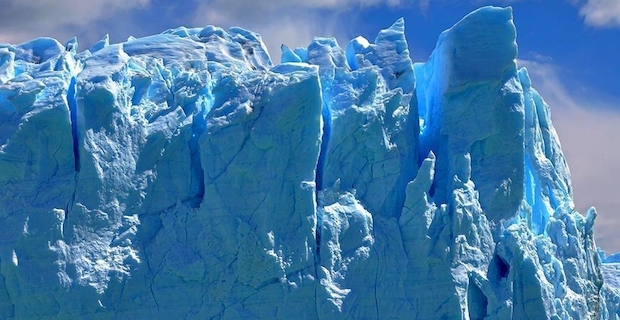A giant iceberg -- the size of greater London -- broke free from Antarctica, researchers said Tuesday. “A huge iceberg (1550 km²), almost the size of Greater London, has broken off the 150m (meter) thick Brunt Ice Shelf,” the British Antarctic Survey (BAS), the UK’s national polar research institute, said on its website. “It calved after cracks that have been developing naturally over the last few years extended across the entire ice shelf, causing the new iceberg to break free,” it added.
The iceberg broke free on Sunday.
“The iceberg calved when the crack known as Chasm-1 fully extended through the ice shelf,” it added.
The break-off occurred a decade after the BAS scientists first noticed the expansion of sizable cracks in the ice, the statement said, adding that it is the second significant calving from this area in the past two years.
Quoting BAS Director Dame Jane Francis, the statement said: “Our glaciologists and operations teams have been anticipating this event.”
The scientists measured the ice shelf multiple times and "how the ice shelf is deforming and moving, and are compared to satellite images from ESA, NASA and the German satellite TerraSAR-X,” Francis added.
“All data are sent back to Cambridge for analysis,” he said. “So we know what is happening even in the Antarctic winter – when there is no staff on the station, it is dark for 24 hours and the temperature falls below minus 50 degrees C (or -58F).”
‘Calving event has been expected’
For his part, a BAS glaciologist Dominic Hodgson said: “This calving event has been expected and is part of the natural behavior of the Brunt Ice Shelf. It is not linked to climate change.”
“Our science and operational teams continue to monitor the ice shelf in real-time to ensure it is safe, and to maintain the delivery of the science we undertake at Halley,” Hodgson added.
The BAS Halley Research Station is situated on Antarctica’s Brunt Ice Shelf. The area of the ice shelf where the research station is located, according to BAS glaciologists who have been observing the ice shelf's behavior, is now “unaffected” by the recent calving occurrences.
According to the statement, the Brunt Ice Shelf's glaciological structure is complex, and the effects of calving episodes are unpredictable. After Chasm-1 started to expand in 2016, BAS scientists moved the station 23 kilometers (14 miles) inland as a precaution.
Since 2017, employees have been deployed to the station only during the Antarctic summer between November to March.
There are currently 21 employees working on the station to maintain the power supplies and facilities that allow scientific studies to continue remotely throughout the winter.
According to satellite monitoring, in 2012 a chasm (Chasm-1) that had been dormant for at least 35 years began to show the first indications of alteration. Since 2015, Chasm-1 has been expanding, and by December 2022, it has spread across the entire ice shelf, signaling the start of the calving event.


 CTCA UK Condemns the Political Forcing Out of Afzal Khan MP for Engaging with Turkish Cypriots
CTCA UK Condemns the Political Forcing Out of Afzal Khan MP for Engaging with Turkish Cypriots Tatar: “Reaction to MP’s TRNC visit is yet another stark example of the Greek Cypriot leadership’s primitive and domineering mentality”
Tatar: “Reaction to MP’s TRNC visit is yet another stark example of the Greek Cypriot leadership’s primitive and domineering mentality” Margaret Greer has been sworn in as the new Mayor of Enfield
Margaret Greer has been sworn in as the new Mayor of Enfield Prime Minister Keir Starmer's 2025 Easter message
Prime Minister Keir Starmer's 2025 Easter message Team Enfield ranks fifteenth the in London Youth Games
Team Enfield ranks fifteenth the in London Youth Games Parking enforcement boosted with more officers on patrol in Enfield
Parking enforcement boosted with more officers on patrol in Enfield Ersin Tatar meets with President Erdoğan
Ersin Tatar meets with President Erdoğan President Ersin Tatar Holds Ministerial-Level Meeting with UK Minister for Europe
President Ersin Tatar Holds Ministerial-Level Meeting with UK Minister for Europe UEFA Europa League and UEFA Conference League draws to be combined into one single show
UEFA Europa League and UEFA Conference League draws to be combined into one single show EuroLeague schedule for 2025-26 season announced
EuroLeague schedule for 2025-26 season announced Zeynep Sonmez becomes first Turkish tennis player to reach third round at Wimbledon
Zeynep Sonmez becomes first Turkish tennis player to reach third round at Wimbledon European champions Arsenal Women will play all of their league matches at the Emirates Stadium
European champions Arsenal Women will play all of their league matches at the Emirates Stadium Enfield Labour welcomes the completion of A10 average speed cameras extension.
Enfield Labour welcomes the completion of A10 average speed cameras extension. TfL opens 2025 grants for community groups to encourage more walking, cycling and active travel in the capital
TfL opens 2025 grants for community groups to encourage more walking, cycling and active travel in the capital Fethiye Launches International Digital Tourism Campaign with UK-Based Publisher
Fethiye Launches International Digital Tourism Campaign with UK-Based Publisher Highlights from the 3rd Trans-Caspian Connectivity Conference in London
Highlights from the 3rd Trans-Caspian Connectivity Conference in London














